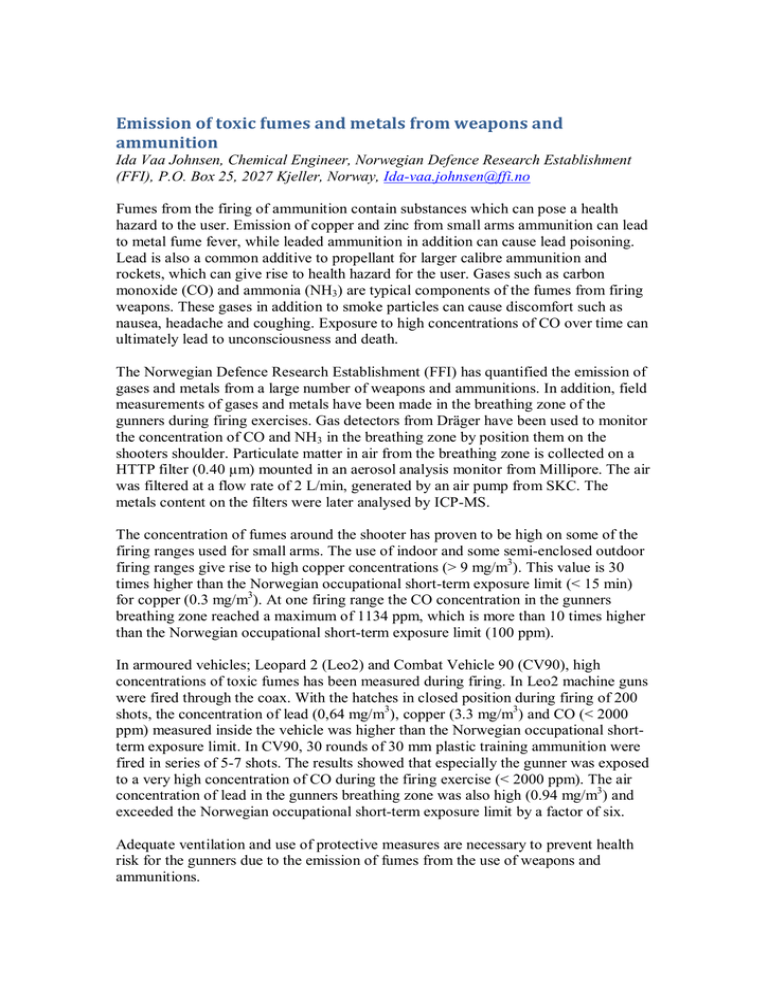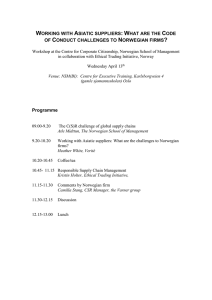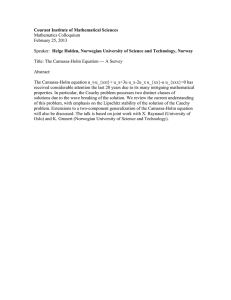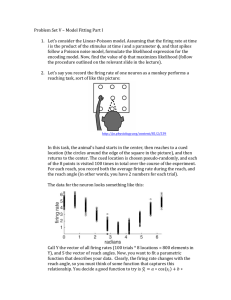Emission of toxic fumes and metals from weapons and ammunition
advertisement

Emissionoftoxicfumesandmetalsfromweaponsand ammunition Ida Vaa Johnsen, Chemical Engineer, Norwegian Defence Research Establishment (FFI), P.O. Box 25, 2027 Kjeller, Norway, Ida-vaa.johnsen@ffi.no Fumes from the firing of ammunition contain substances which can pose a health hazard to the user. Emission of copper and zinc from small arms ammunition can lead to metal fume fever, while leaded ammunition in addition can cause lead poisoning. Lead is also a common additive to propellant for larger calibre ammunition and rockets, which can give rise to health hazard for the user. Gases such as carbon monoxide (CO) and ammonia (NH3) are typical components of the fumes from firing weapons. These gases in addition to smoke particles can cause discomfort such as nausea, headache and coughing. Exposure to high concentrations of CO over time can ultimately lead to unconsciousness and death. The Norwegian Defence Research Establishment (FFI) has quantified the emission of gases and metals from a large number of weapons and ammunitions. In addition, field measurements of gases and metals have been made in the breathing zone of the gunners during firing exercises. Gas detectors from Dräger have been used to monitor the concentration of CO and NH3 in the breathing zone by position them on the shooters shoulder. Particulate matter in air from the breathing zone is collected on a HTTP filter (0.40 µm) mounted in an aerosol analysis monitor from Millipore. The air was filtered at a flow rate of 2 L/min, generated by an air pump from SKC. The metals content on the filters were later analysed by ICP-MS. The concentration of fumes around the shooter has proven to be high on some of the firing ranges used for small arms. The use of indoor and some semi-enclosed outdoor firing ranges give rise to high copper concentrations (> 9 mg/m3). This value is 30 times higher than the Norwegian occupational short-term exposure limit (< 15 min) for copper (0.3 mg/m3). At one firing range the CO concentration in the gunners breathing zone reached a maximum of 1134 ppm, which is more than 10 times higher than the Norwegian occupational short-term exposure limit (100 ppm). In armoured vehicles; Leopard 2 (Leo2) and Combat Vehicle 90 (CV90), high concentrations of toxic fumes has been measured during firing. In Leo2 machine guns were fired through the coax. With the hatches in closed position during firing of 200 shots, the concentration of lead (0,64 mg/m3), copper (3.3 mg/m3) and CO (< 2000 ppm) measured inside the vehicle was higher than the Norwegian occupational shortterm exposure limit. In CV90, 30 rounds of 30 mm plastic training ammunition were fired in series of 5-7 shots. The results showed that especially the gunner was exposed to a very high concentration of CO during the firing exercise (< 2000 ppm). The air concentration of lead in the gunners breathing zone was also high (0.94 mg/m3) and exceeded the Norwegian occupational short-term exposure limit by a factor of six. Adequate ventilation and use of protective measures are necessary to prevent health risk for the gunners due to the emission of fumes from the use of weapons and ammunitions. Biographyoftheauthor Ida Vaa Johnsen is a chemical engineer working for the Norwegian Defense Research establishment (FFI). Ida Has worked at FFI for a little more than two years. Before that, she took a master’s degree in environmental/analytical chemistry at the Norwegian university of life science (in Ås). At FFI Ida works with metal pollution in soil at shooting ranges and emission of metals and fumes from weapons and ammunition.




